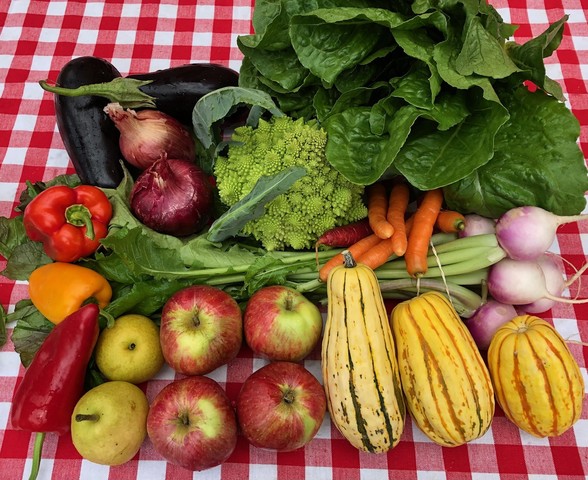- Violet Queen Turnips
- Carrots
- Sweet Sixteen Apples
- Delicata Winter Squash
- Eggplant
- Rossa di Milano Red Onions
- Sweet Peppers
- Nijiseiki Asian Pears
On Rotation
- Romanesco Cauliflower
- Head Lettuce
Two of my all-time fall favorites are coming into season this week: romanesco cauliflower and Delicata winter squash. The romanesco will be on rotation for the next month+, so you should see it once or twice in your tote this fall. It has wonderful, nutty, cauliflower flavor - great roasted, but also steamed or raw. The only problem with romanesco is bringing yourself to actually eat it! Many a CSA member has opted to gaze at it instead, celebrating the visual feast of neon green spiral fractals.
We're kicking off our fall winter squash line-up with Delicata this week. If ever there was the perfect "gateway" winter squash, this is it: incredibly sweet, easy to cook, and palate-pleasing for anyone who can manage soft foods (6 months to 120!). :-) Delicata have always been my favorite, and seem to be the most popular among our customers in general. Here are a few tips and tricks to Delicatas, and winter squash in general (which you'll see in your tote every week for the rest of the season, until mid-December. This is week 19 of 28, for anyone who's wondering how much longer the CSA will go....):
- Delicatas have thin skin by winter squash standards, and it's edible. If you don't feel like peeling them, no need to bother. Personally, I like to leave the skin on if I'm cutting them in half and baking them. To bake: cut in half the long way, scoop out the seeds, place face down on a baking pan with enough water to cover the bottom of the pan, and bake at 400 until soft. Then, fill the piping hot squash boats with butter, watch it melt into a delectable pool, and dive in with a spoon! If I'm cutting them up into smiles or cubes to roast, I like to peel them first: grab a veggie peeler to remove the skin, cut ends off, then cut in half and scoop out the seeds. Toss with olive oil, salt and pepper and roast at 400 until soft and crispy-brown on the edges.
- The rest of the winter squash you'll see this fall can be slightly more hazardous to work with in the kitchen, due to their large size, round shape, and/or tougher skins. Knife safety is paramount. If you are timid with knives and have a microwave, you might consider poking a few holes through the skin with a the tip of a sharp knife and then popping your whole squash in the microwave just long enough to soften it a bit. Then proceed with cutting it in half or into pieces. If you don't have a microwave like me, I am strategic about using my heavy duty pointy-tipped chef's knife when I tackle a squash. I insert the tip into the squash (careful to not let the squash roll to the side and cause your knife to slip), then carefully work the blade around the circumference of the squash until it's cleaved in two. Some varieties, like butternut and various kabochas, lend themselve to peeling. Other types, like spaghetti and acorn, have hard outer shells that I always leave in place (acorns have such a hard shell they double as a great soup bowl).
- All of the winter squash are shelf-stable and will keep on your countertop for weeks, if not months. No need to refrigerate.
Have a great week and enjoy the new fall flavors!

